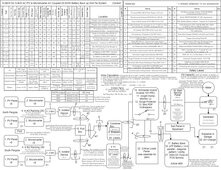SparkyGriswald
New Member
I am centerfeeding a string of 16 M215 Enphase Miroinverters (so the junction box is in the middle of 2 sets of 8 MI). Altogether this would be 16 MI that would land on the breaker in the Enphase Combiner box and I am wondering if this should be 20A or 30A.
The current per MI is 0.9 so 16* 0.9 = 14.4 then multiply that by 1.25 (per NEC 690.8(A) = 18 and then multiply again by 1.25 (per NEC 690.8(B) for a total 22.5A
If it at all matters the reason I went with MI is because we have had issues with shading and so my expectation of the 16 to be fully producing is low. But that likely does not matter to an inspector right?
The current per MI is 0.9 so 16* 0.9 = 14.4 then multiply that by 1.25 (per NEC 690.8(A) = 18 and then multiply again by 1.25 (per NEC 690.8(B) for a total 22.5A
If it at all matters the reason I went with MI is because we have had issues with shading and so my expectation of the 16 to be fully producing is low. But that likely does not matter to an inspector right?



